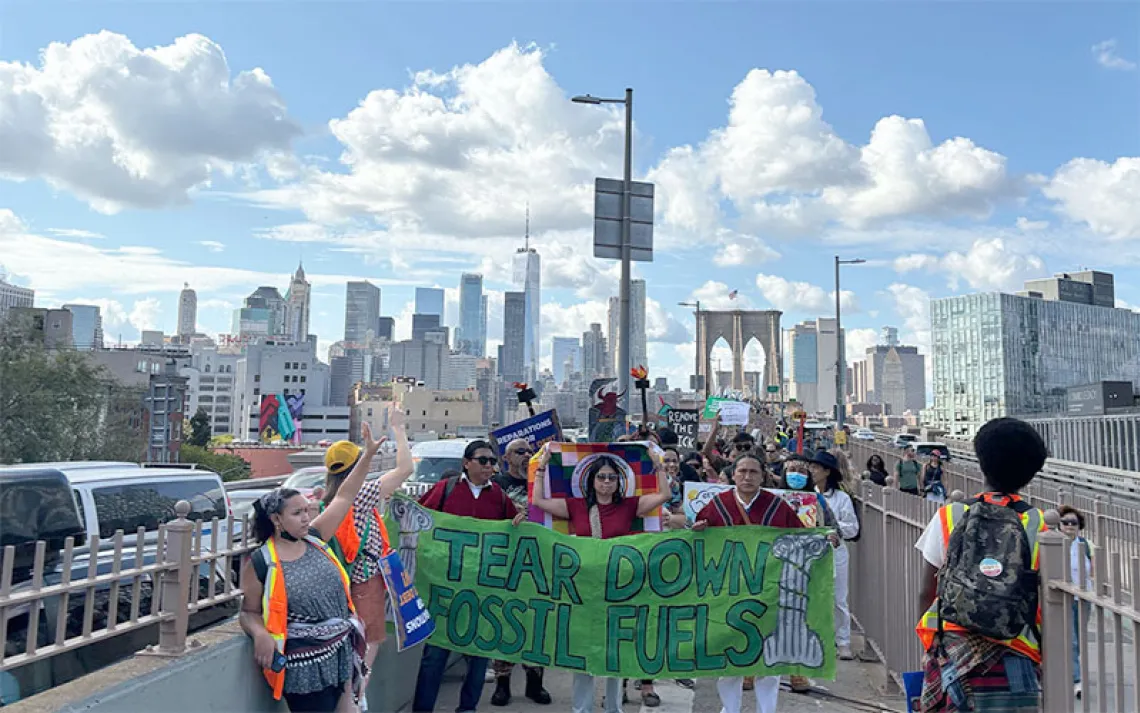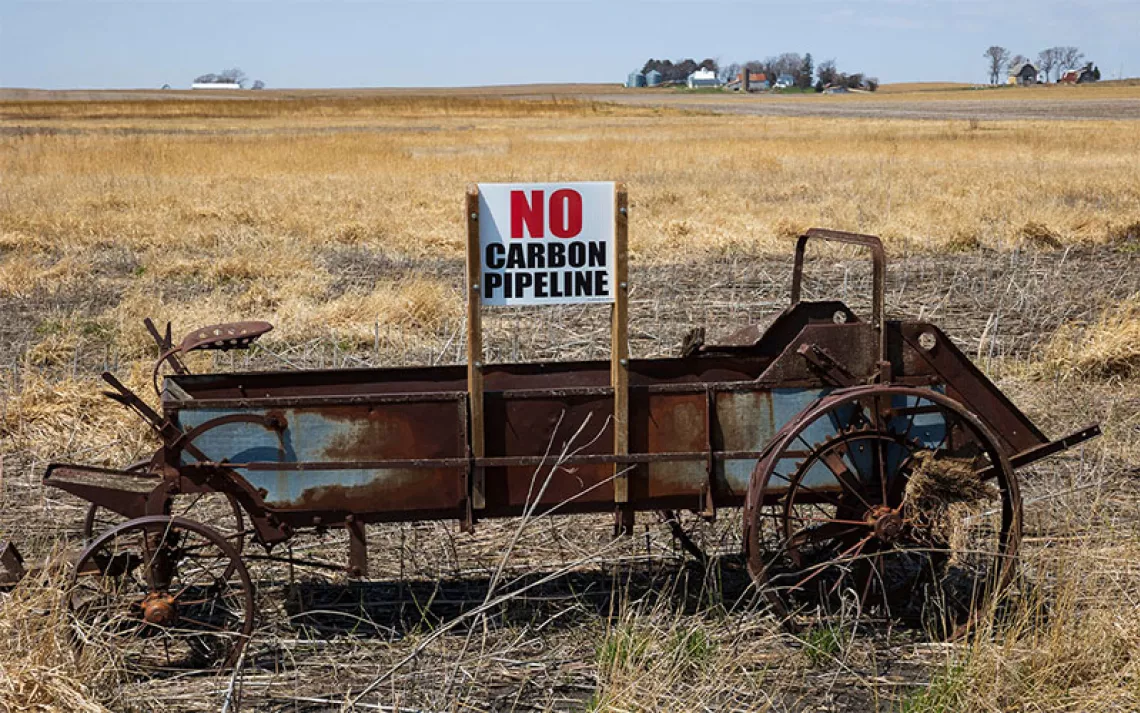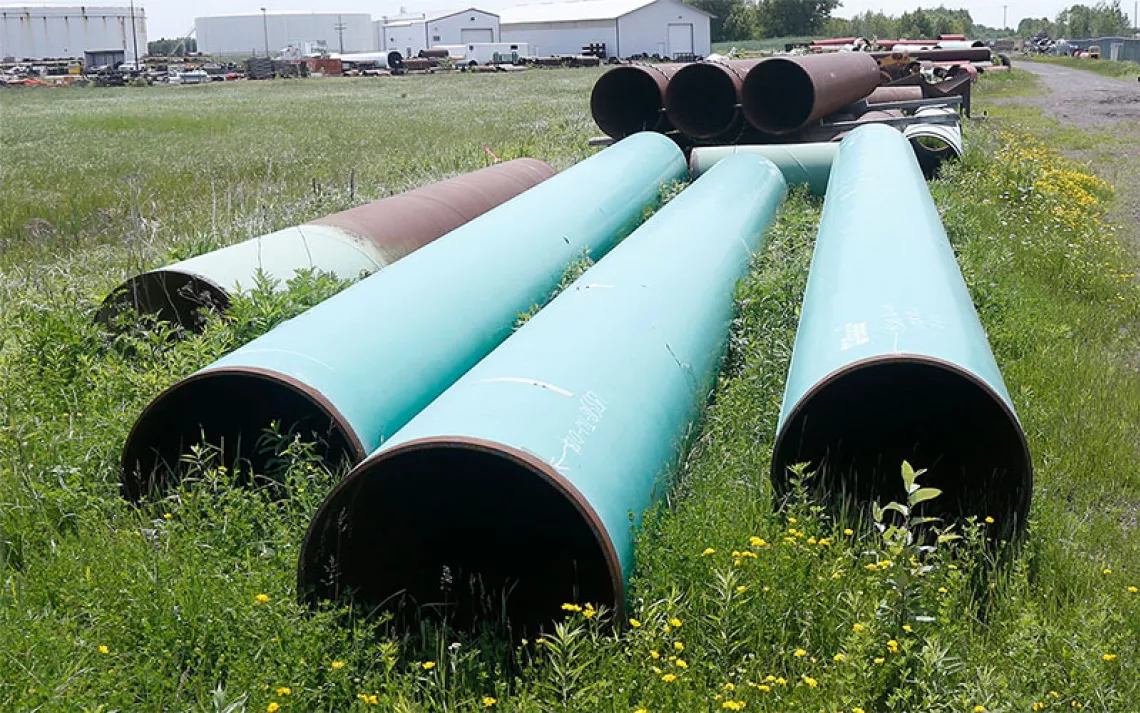Here’s How We Defeated the Keystone XL Pipeline
A cofounder of 350.org recounts the decade-long effort to stop KXL

Protesters gather on the north side of the White House after then-president Donald Trump announced two executive orders to advance the Keystone XL and Dakota Access Pipelines on January 24, 2017. | Photo by Riccardo Savi/Sipa via AP Images
It was the first night of our sit-in at the White House against the Keystone XL Pipeline and already things weren’t going according to plan.
Our team at Tar Sands Action, an organization that 350.org set up to coordinate the protest, had invited hundreds of people to come to Washington, DC, for two weeks in August 2011 to push President Obama to reject Keystone XL, the proposed 1,400-mile-long pipeline that would run from the tar sands mines in Alberta, Canada, to the Gulf of Mexico. For the first three years of the Obama presidency, the mainstream climate movement had largely played nice with the administration, trying (and failing) to pass a comprehensive climate bill, applauding the administration’s other environmental actions, and expressing little more than “serious concern” about the administration’s moves to expand oil and gas production.
The gloves were coming off. Beginning in spring 2011, a group of us had been discussing the idea of planning a large-scale act of civil disobedience to challenge President Obama on climate, especially his support for an “all of the above” energy strategy that continued to prioritize fossil fuels. Inspired by the Indigenous-led resistance against the Canadian tar sands and growing opposition along the pipeline route, we seized on Keystone XL as the place to take our stand. Keystone required a presidential permit to cross the US border with Canada, so the project was a clear way to test Obama’s commitment to keeping fossil fuels in the ground. Either he signed off on what we were now calling “the fuse to the largest carbon bomb on the planet,” or he didn’t. Keystone XL could be a clear line in the sand: We just had to draw it.
We picked the last two weeks of August for our protest at the White House because we knew they were the deadest media weeks of the year. Back in 2011, it was nearly impossible to get the political press to cover climate change, let alone a then-obscure pipeline route thousands of miles outside the DC Beltway, so we thought our best chance at capturing the spotlight would be to rush the stage when no one else was around and then . . . just stay there.
Despite its long history in American social change movements, civil disobedience was a new thing for some climate activists, so we tried to make the protest as accessible and as well organized as possible. For example, we told people to leave their T-shirts at home and come dressed formally in their “Sunday best,” an intentional homage to the civil rights movement. We also set up the protest so that the arrest would result in a “post and forfeit” situation. Participants would be asked to pay a fine of around $200 and then be released with no permanent charges. No one would be spending the night in jail—or so we thought.
As it turned out, despite our many meetings with the DC Park Police to explain exactly what we were planning, when presented with the reality of over 100 people sitting-in at the White House fence, the police panicked. Instead of being cited and released, all the first day’s participants—including our ringleader, author and environmentalist Bill McKibben, and luminaries like Gus Speth, who led the Carter administration’s Council on Environmental Quality—were taken down to DC central booking and thrown in a jail cell.
The rest of us were left with a tough call: How could we continue the protest? Were we equipped to support this many people going to jail? How far were we willing to go with this? As our team of organizers huddled up at All Souls Church in Columbia Heights debating the right call, we got a message that a lawyer had smuggled out of our friends’ jail cell. “The only thing we need,” it read, “is more company.”
Over the next two weeks, 1,238 people would be arrested at the sit-ins against Keystone XL—including Sierra Club executive director Michael Brune and then–Sierra Club president Allison Chin, marking the first time the organization ever participated in civil disobedience It was the largest coordinated act of civil disobedience in decades, not only for the environmental movement but also for the country as a whole. When it became clear by the third day that we weren't going away, the police released our friends in jail and started citing and releasing people as we’d expected. As more people got arrested, the press coverage began to pick up, but the overwhelming majority of it was negative. Pundits and other Very Important People dismissed the protests as misguided or doomed to fail. When the National Journal polled its “Energy Insiders” about Keystone XL, 91 percent of them said that the pipeline would be approved within the year.
What those pundits and self-described experts didn’t understand was that the protest had sparked a fire in people across the country. For many of us who took part in the sit-ins, it was a transformative experience. I still run into people today who remember their number in the count of arrestees. Others tell me it was the moment they decided to devote their lives to the climate movement. Whenever there’s a major announcement on Keystone XL, I watch my Facebook feed fill with people posting photos of their arrest. As acts of civil disobedience go, our sit-in at the White House was low consequence—many activists, and especially activists of color and other marginalized communities, take far greater risks all the time—but the experience of crossing the line together, of breaking the law for something we believed in, clearly radicalized people.
It also inspired tens of thousands more who were watching the protests online. When we put out a call for people to return to Washington in November, we were optimistically aiming for a few thousand so that we could completely join hands around the White House (I’d mapped it out on Google and come to a rough count for how many folks we’d need). So we were blown away when more than 10,000 people showed up, enough to ring the White House three to five people deep. We weren’t the only ones who were shocked: A few days after our demonstration, President Obama delayed a decision on Keystone XL until after the 2012 election.
Or so he thought. When congressional Republicans passed an order that placed an arbitrary deadline of February 21, 2012, for the White House to make a decision on the pipeline, President Obama called their bluff and rejected the permit for the project but left energy infrastructure company TransCanada room to reapply, which it promptly did.
Despite the White House’s best efforts, Keystone XL was now an unavoidable election issue. Everywhere that Obama went on the campaign trail that year, activists would meet him, shouting questions about the pipeline. It got so bad that people close to the campaign and the White House called us repeatedly to tell us that if we didn’t quit it, we could cost Obama the election. We knew that was bogus and so we committed to redouble our efforts.

Photo courtesy of Javier Sierra
As we told our contacts within the White House, we weren’t there to “protest Obama,” whom we knew wanted to do the right thing. We were there, as President Franklin Delano Roosevelt had urged activists in his day, to “make him do it.” I’d campaigned for Obama in 2008 and 2012 (just like I campaigned for Biden in 2020) and wanted him to succeed. But for me, that was all the more reason to apply pressure. A presidential legacy isn’t created solely by who sits in the Oval Office; it’s sculpted by the movements that push an administration to live up to its full potential.
After Obama won reelection in 2012, we continued to push. Keystone XL was now officially a political football, and over the next three years, congressional Republicans and the White House continued to kick it back and forth with bills, resolutions, vetoes, and other political maneuvers. We did our best not to get distracted by the inside game in Washington and instead focused on our proven recipe for success: engaging a broad, diverse coalition in creative, mass actions that forced the fight forward.
The next few years were full of protests. On a bitterly cold day in February 2013, just a month after Obama’s second inauguration, we organized “Forward On Climate,” bringing some 40,000 people together in Washington, DC, to urge the administration to reject Keystone XL and dedicate its second term to climate action. In April 2014, farmers, ranchers, and Indigenous leaders came together to form the Cowboy and Indian Alliance and assembled tepees and a Conestoga wagon on the National Mall for “Reject and Protect.” That September, when we organized the People’s Climate March, flooding New York City with over 400,000 people, we made sure that Keystone XL was a top demand.
To be honest, it was exhausting. What we’d planned as a one-off act of civil disobedience at the White House had now turned into a multiyear saga with no end in sight. We’d joke on organizing calls that we’d still be fighting KXL from our nursing homes, hobbling out on walkers for yet another protest. But those of us at the national level took endless inspiration from those along the pipeline route, especially our Indigenous allies, who reminded us that they’d been fighting for their land, whether against pipelines or settlers, for generations. If they weren’t giving up, neither would we.
Ultimately, our faith and tenacity were rewarded, only to be tested again. As the Paris climate talks approached at the end of 2015, we made it clear that there was no way President Obama could lead the world on climate with a pipeline hanging around his neck. And so, on Friday, November 6, just a few weeks before the climate talks were scheduled to begin, Obama stood with Secretary of State John Kerry and Vice President Joe Biden and rejected the permit for Keystone XL.
“America is now a global leader when it comes to taking serious action on climate change,” Obama said. “Frankly, approving that project would have undercut that global leadership, and that is the biggest risk we face: not acting.”
Little did Obama know that the biggest risk wasn’t inaction; it was that weekend’s host of Saturday Night Live: Donald J. Trump. When Trump approved the cross-border permit for Keystone XL on day one of his presidency, the usual pundits once again told us the fight was doomed. We once again went back to basics: investing in our coalitions, getting creative with our protests, and keeping up the fight.
We built solar arrays along the route of the pipeline; brought hundreds of thousands to DC for another People’s Climate March; got tens of thousands to sign a “Promise to Protect,” committing to engage once again in civil disobedience if pipeline construction began; continued to build opposition at the state and local level; and, critically, fought the project in the courts, winning a number of key decisions that slowed down the project.
Social change work is often a war of attrition—a contest of stamina between defenders of the status quo and those demanding progress. We were ready to sustain the siege. By the time TransCanada, now called TC Energy, was able to begin construction on the pipeline in April 2020, it was too late. With the COVID-19 pandemic underway and the election fast approaching, the company had run out of time to complete the project while Trump was still in office. Last May, Biden committed on the campaign trail to reject Keystone XL if elected. And last week, on January 20, as one of his first acts as president, Biden made good on his word and revoked the permit for the project.
After the seemingly endless battle against this zombie pipeline, it’s hard to believe that Keystone XL is actually dead, but every sign points in that direction. After some tepid words expressing his disappointment, Canadian prime minister Justin Trudeau seems to have moved on. TC Energy itself says it’s re-evaluating the project. Sure, there will be more lawsuits, maybe even a NAFTA complaint, but the fact is that the world has fundamentally changed since 2008, when the pipeline was first proposed. Oil prices are down, clean energy is ascendent, and investors are turning their backs on fossil fuels. Meanwhile, our movement has not only made climate change a top concern for huge portions of the public, but it has also shown that we’ll fight every new fossil fuel project that’s proposed—and that we’ll often win. As one energy executive complained, there’s been a “Keystone-ization” of every project across North America. Or as Bloomberg News put it this summer, pipelines are now “nearly impossible to build.”
But “nearly impossible” isn’t the same thing as “impossible,” and so the fight goes on. As I write, Indigenous water protectors and their allies in Minnesota are battling against Line 3, another dangerous tar sands pipeline. In West Virginia and Virginia, activists are fighting the Mountain Valley Pipeline that would carry dirty fracked gas across Appalachia. In Texas, and all along the Gulf Coast, frontline communities are leading the resistance against more pipelines and LNG export terminals. The list goes on and on: Everywhere you look, struggles against fossil fuel projects are underway.
The sheer number of fights is a sign of how much work is left to be done, but also how far we’ve come. When we put out the call back in 2011 for people to come to the White House and get arrested to stop a tar sands pipeline, we had no idea how many people were going to show up. Now, I have no doubt that it would be in the tens of thousands (something for the Biden administration to keep in mind). As the story of Keystone XL shows, no fossil fuel project is inevitable. Wherever people are willing to take a stand, there’s a battle to be won. May our victories be fuel for the fights to come.
 The Magazine of The Sierra Club
The Magazine of The Sierra Club



